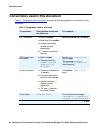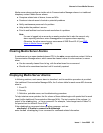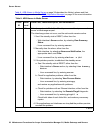
Server Alarms
32 Maintenance Procedures for Avaya Communication Manager 3.0, Media Gateways and Servers
2. Enable the modem from the media server Web Interface. In addition, use the Setup Modem
Interface under the Configure Server pages.
3. With this modem, a client PC uses the Point-to-Point Protocol (PPP) to access the media
server and connect via telnet to a Linux shell.
4. Once logged into the media server, you can telnet out to media gateways, such as the
G700, and other devices on the network.
Note:
Note: Additionally, this modem can be used to allow the media server to call out to the
INADS or other alarm receiving system to report alarms. When performing
remote diagnostic tests, Services personnel should disable alarm call-outs to
INADS to avoid generating unnecessary alarms. Alarm suppression is released
after 30 minutes. If you are remotely logged in through the modem you prevent
alarms from being sent because you are using the modem, but you do not
prevent an alarm noting the absence of alarm reporting service being logged at
the alarm receiving site.
The VPN alternative is achieved by the use of the Intelligent Site Manager (ISM) application.
The ISM is a VPN gateway that resides on the customer’s LAN and provides a means for
services personnel to gain access to the customer’s LAN in a secure manner over the Internet.
Telnet is then used to access the media server and/or media gateways and other IP network
equipment.
Alarms in Linux Media Servers
S8700 | 8710 / S8500 / S8300
A Linux-based media server can be configured so that it serves as the trap collector and
provides external alarm notification.
A process called the Global Maintenance Manager (GMM) runs on the media server and
collects events that are logged to the Linux syslog_d process. These events consist primarily of
failure notification events logged by Communication Manager and INTUITY maintenance
subsystems, or of traps sent by media gateways (
G700). For events that require external
notification, one option is to call the Avaya technical service center’s INADS (Initialization and
Administration System). However, other possible options include sending an e-mail to specified
destinations, or sending an SNMP trap to a specified network management address.
The media server has an SNMP trap manager that collects traps from:
● Uploads and downloads to media modules
● VoIP Media Modules
● VoIP engines on G700 motherboards
● G700-associated UPS systems


















